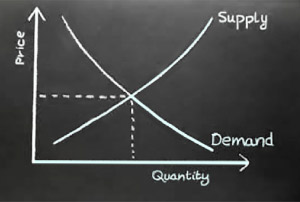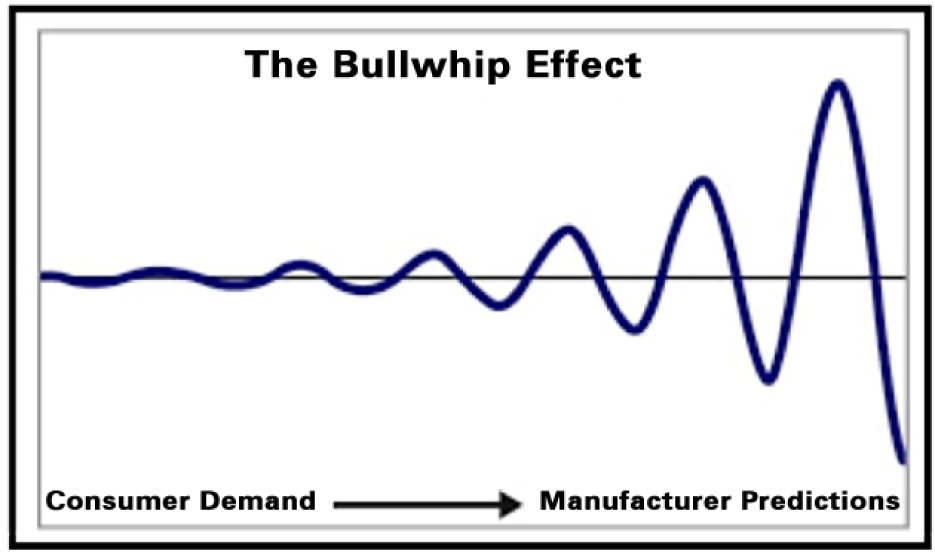The Law of Supply and Demand
Ed Hill
Synchronous Solutions
The law of supply and demand is a theory that explains the interaction between the sellers and buyers of a product or service. The theory defines what effect the relationship between the availability of a product and the demand for that product has on its price. Generally, low supply and high demand will increase the price and vice versa.
The law of supply and demand is one of the most basic principles of economics. In practice, supply and demand pull against each other until the market finds an equilibrium price, but many factors can affect both supply and demand, causing them to increase or decrease in various ways.
The current Coronavirus Pandemic has created havoc in the supply chain of virtually every product we consume.
 |
|
Diagram One |
Law of Demand Versus Law of Supply
The law of demand states that, if all other factors remain equal, the higher the price of a product, the less people will demand that product. In other words, the higher the price, the less attractive the product will be to the consumer. As a result, people will naturally avoid buying a product that is priced too high and that will encourage them toward the consumption of something else they value more. Diagram One shows that the curve is a downward slope.
Like the law of demand, the law of supply demonstrates the quantities that can be sold at a certain price. The upward slope in the chart above means that the higher the price, the higher the quantity that producers will supply because selling a higher quantity at a higher price increases revenue.
But, unlike the demand relationship, the Law of Supply is a factor of time. Time is important to supply because producers must react quickly to a change in demand or price. It is important for all producers to focus on the status of the market as they try to determine when the price can change in relation to the current demand. Pricing levels should always be considered temporary. I assure you that your customers will do just that.
The fact is, pricing your products is far from an exact science. Ultimately, it is all about what the market will bear.
As stated in a previous article (Pricing Your Products, November 2019):
The price of your products is determined by your customer’s perception of value and availability.
Value has to do with the worth of the product relative to its price. Availability has to do with how quickly the product can be accessible by the consumer. Smart producers will understand and be responsive to both these conditions. When pricing is reasonable and quality is good, the producer who can serve the market most rapidly will get the business.

Beware of the Bull Whip Effect
Supply Chain Scientists have identified what is called “The Bull Whip Effect” which recognizes that minor changes in demand can cause dramatic effects on the supply chain as companies try to gauge the change while maintaining capacity and inventory necessary to meet the demand.

Let’s say on a hot weekend there’s a sudden and unexpected increase in the demand of cold beer at convenience stores. On Monday morning the managers of those convenience stores will increase their orders beyond normal levels to replenish their inventories and in anticipation of continued higher demand. The distributors serving those stores will also experience diminished inventories and will increase orders to the manufacturers. The manufacturers, seeing unexpected demand on their products, will ramp up production and overtime costs to meet the needs and in anticipation of continued strong orders. The effect on the manufacturer can be dramatic. The ultimate loser of this business reality is the manufacturer.
This story is described in further detail in The Fifth Discipline by Peter Senge. The concept has been expanded into a Supply Chain simulation exercise called The Beer Game, which allows students to experience the impacts of The Bull Whip Effect and to learn how to prevent it.
 Having taught this concept during my tenure at Clemson University, I believe the principles of this phenomenon are applicable to the granite processing industry. No doubt, there will be pent-up demand for your products across the entire supply chain.
Having taught this concept during my tenure at Clemson University, I believe the principles of this phenomenon are applicable to the granite processing industry. No doubt, there will be pent-up demand for your products across the entire supply chain.
Supply Chains always overreact. Some are better than others, but they all experience increased impacts as the demand signals travel upstream. The solution is better communication and less exaggerated replenishment decisions as supply chain elements try to protect against stockout conditions only to build excessive inventories at increased costs.
Countertop manufacturers and all their suppliers should expect pent-up demand to hit their order departments in the coming months. This reaction can cause the Bull Whip Effect in the entire supply chain. Planning for various scenarios rather than reacting to the most recent order volume is a much better approach.
Supply Chains are sensitive structures. Each element is both dependent and responsive to every other element. The current coronavirus pandemic has enormously disrupted the supply chain of every item we consume. Both supply and demand signals have been disturbed across the globe.
Enormous pent-up demand has already begun to emerge in many market areas. Every product line can expect significant challenges in navigating the return of a strong economy in the months to come.
For more information on Supply Chain Science and how to be prepared for the coming resurgence of the economy,
contact Ed Hill at Synchronous Solutions, 704-560-1536, www.SynchronousSolutions.com .